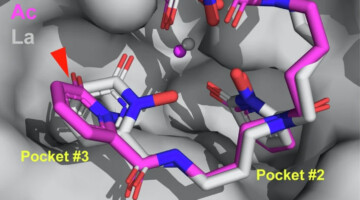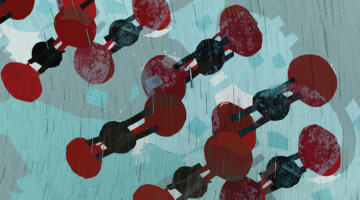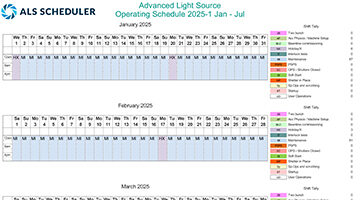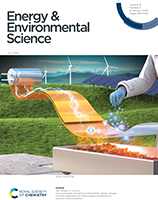Researchers found that charge density waves (CDWs) in topological materials induce unconventional spectral gaps in the materials’ electronic structure. The finding that CDWs in topological materials can be essentially different from those in other materials should be carefully considered when designing quantum devices. Read more »![]()
A Macromolecular Scaffold for Probing Actinium Chemistry
By encapsulating actinium atoms within a macromolecular complex for analysis using protein crystallography, researchers discovered that actinium has a unique solid-state bonding configuration. A better understanding of actinium behavior could help improve a promising cancer treatment known as targeted alpha therapy. Read more »![]()
![]()
Lattice-Dependent Spin Textures in High-Tc Superconductors
Researchers found that in bismuth-based cuprate superconductors, charge imbalances caused by lattice distortions generate persistent and universal patterns of spin polarization. The results supply a previously missing but essential ingredient in efforts to understand the mechanisms driving the electronic behavior of high-temperature superconductors. Read more »![]()
![]()
Excited States in CO2 Clusters Shed Light on Astrochemical Formation Mechanisms
A vacuum ultraviolet photoionization study conducted at the ALS revealed a new mechanism between molecules that converts high-energy ultraviolet light into free electrons. The results provide insights into interactions between CO2 and organic molecules, which are crucial for understanding astrochemical interactions as well as green chemistry and renewable energy development. Read more »
January-July 2025 Operating Schedule Announced
The operating schedule for the 2025-1 cycle (January-July 2025) has been posted. The next long shutdown will begin in January 2025 and is expected to last 11 weeks. The most up-to-date information on the current schedule and future outlook can always be found on the Operating Schedule web page. Read more »
Nanoconfinement of High Hydrogen-to-Metal Ratio Lanthanum Hydrides in Functionalized Carbon Hosts
Metal hydrides with a high hydrogen content are important for materials-based hydrogen storage and high-temperature superconductivity. Nanoconfinement of metal hydrides in porous hosts is a promising strategy to tune the thermodynamic stability and control the hydrogen-to-metal ratio. X-ray absorption and photoelectron spectroscopy provided detailed information about the local chemical environment of LaHx species within carbon hosts. Read more »
Local Chemical Enhancement and Gating of Organic Coordinated Ionic-Electronic Transport
Record ion mobility and conductivities are revealed within a nanoscopic interfacial superhighway of an organic mixed ionic-electronic conductor. Fast ion transport can be controlled by hydrophobicity of molecules local to this channel, effectively gating ion access to the superhighway. This mechanism is used in a novel chemical sensing device which detects the dynamics of a local, buried chemical reaction. Read more »
Advancing high-temperature electrostatic energy storage via linker engineering of metal–organic frameworks in polymer nanocomposites
High-performance, thermally resilient polymer dielectrics are essential for film capacitors used in advanced electronic devices and renewable energy systems, particularly at elevated temperatures where conventional polymers fail to perform. Herein, we unravel the untapped potential of UiO-66 metal–organic framework (MOF) derivatives as exceptional nanofillers for tuning the properties of the widely used polyetherimide (PEI). Read more »
Jamming Giant Molecules at Interface in Organic Photovoltaics to Improve Performance and Stability
Giant molecule acceptors (GMAs), known for their large size and intricate functional structures, are an emerging focus in materials science. Through implementation of an interface-enhanced layer-by-layer fabrication strategy, we have successfully demonstrated that GMA with designed electronic structure at interfaces can effectively improve OPV device performance. Read more »
Magnetization Switching in Highly Magnetostrictive Microstructures
Researchers learned how the size, shape, and orientation of microstructures affect how they switch magnetization directions in response to an applied voltage. The work advances our understanding of strain-responsive composite materials for use in energy-efficient electronic applications such as memory devices, sensors, and actuators. Read more »![]()
![]()
- « Previous Page
- 1
- 2
- 3
- 4
- 5
- …
- 83
- Next Page »









